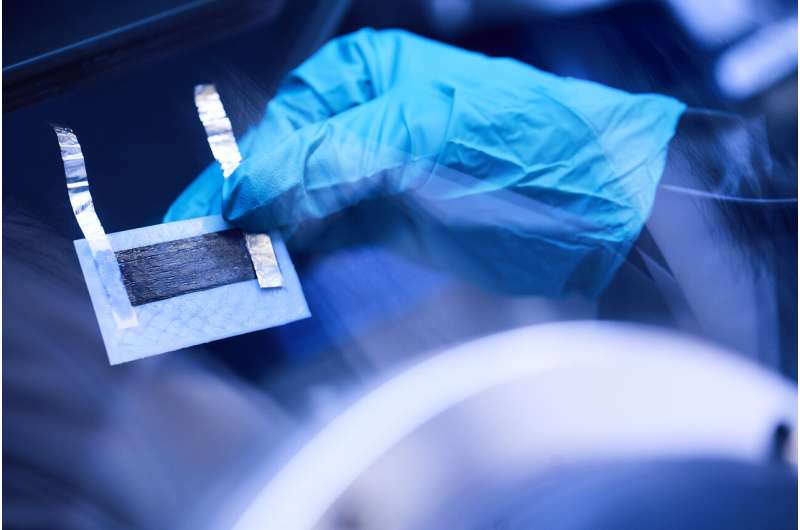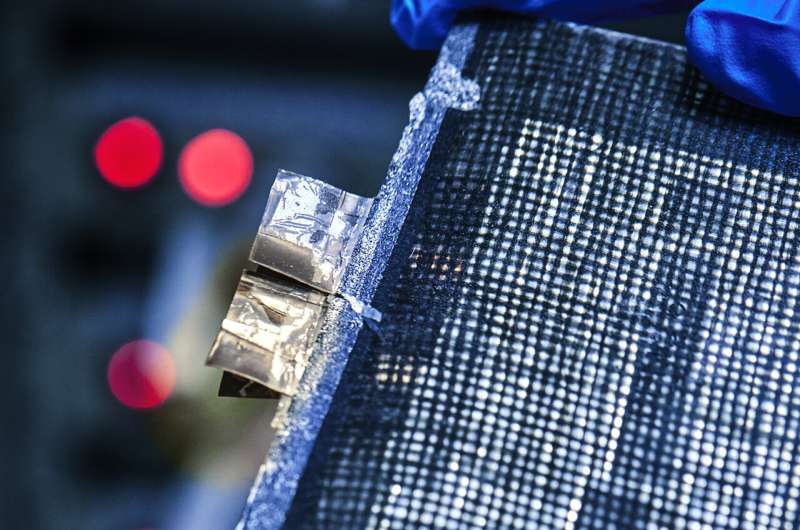This article has been reviewed according to Science X's editorial process and policies. Editors have highlighted the following attributes while ensuring the content's credibility:
fact-checked
peer-reviewed publication
trusted source
proofread
Carbon fiber structural battery battery paves way for light, energy-efficient vehicles

When cars, planes, ships or computers are built from a material that functions as both a battery and a load-bearing structure, the weight and energy consumption are radically reduced. A research group at Chalmers University of Technology in Sweden is now presenting a world-leading advance in so-called massless energy storage—a structural battery that could halve the weight of a laptop, make the mobile phone as thin as a credit card or increase the driving range of an electric car by up to 70% on a single charge.
"We have succeeded in creating a battery made of carbon fiber composite that is as stiff as aluminum and energy-dense enough to be used commercially. Just like a human skeleton, the battery has several functions at the same time," says Chalmers researcher Richa Chaudhary, who is the first author of an article recently published in Advanced Materials.
Research on structural batteries has been going on for many years at Chalmers, and in some stages also together with researchers at the KTH Royal Institute of Technology in Stockholm, Sweden. When Professor Leif Asp and colleagues published their first results in 2018 on how stiff, strong carbon fibers could store electrical energy chemically, the advance attracted massive attention.
The news that carbon fiber can function as electrodes in lithium-ion batteries was widely spread and the achievement was ranked as one of the year's ten biggest breakthroughs by Physics World.
Lower weight requires less energy
Since then, the research group has further developed its concept to increase both stiffness and energy density. The previous milestone was reached in 2021 when the battery had an energy density of 24 watt-hours per kilogram (Wh/kg), which means roughly 20% capacity of a comparable lithium-ion battery.
Now it's up to 30 Wh/kg. While this is still lower than today's batteries, the conditions are quite different. When the battery is part of the construction and can also be made of a lightweight material, the overall weight of the vehicle is greatly reduced. Then not nearly as much energy is required to run an electric car, for example.

"Investing in light and energy-efficient vehicles is a matter of course if we are to economize on energy and think about future generations. We have made calculations on electric cars that show that they could drive for up to 70% longer than today if they had competitive structural batteries," says research leader Leif Asp, who is a professor at the Department of Industrial and Materials Science at Chalmers.
When it comes to vehicles, of course, there are high demands on the design to be sufficiently strong to meet safety requirements. There, the research team's structural battery cell has significantly increased its stiffness, or more specifically, the elastic modulus, which is measured in gigapascal (GPa), from 25 to 70. This means that the material can carry loads just as well as aluminum, but with a lower weight.
"In terms of multifunctional properties, the new battery is twice as good as its predecessor—and actually the best ever made in the world," says Leif Asp, who has been researching structural batteries since 2007.
Several steps towards commercialization
From the start, the goal was to achieve a performance that makes it possible to commercialize the technology. In parallel with the fact that the research is now continuing, the link to the market has been strengthened—through the newly started Chalmers Venture company Sinonus AB, based in Borås, Sweden.
However, there is still a lot of engineering work to be done before the battery cells have taken the step from lab manufacturing on a small scale to being produced on a large scale for our technology gadgets or vehicles.
"One can imagine that credit card-thin mobile phones or laptops that weigh half as much as today, are the closest in time. It could also be that components such as electronics in cars or planes are powered by structural batteries. It will require large investments to meet the transport industry's challenging energy needs, but this is also where the technology could make the most difference," says Leif Asp, who has noticed a great deal of interest from the automotive and aerospace industries.

More about the research and structural batteries
Structural batteries are materials that, in addition to storing energy, can carry loads. In this way, the battery material can become part of the actual construction material of a product, which means that much lower weight can be achieved on, for example, electric cars, drones, handheld tools, laptops and mobile phones.
The latest advances in this area have been published in the article "Unveiling the Multifunctional Carbon Fiber Structural Battery," and the authors are Richa Chaudhary, Johanna Xu, Zhenyuan Xia and Leif Asp at Chalmers University of Technology.
The developed battery concept is based on a composite material and has carbon fiber as both the positive and negative electrodes—where the positive electrode is coated with lithium iron phosphate. When the previous battery concept was presented, the core of the positive electrode was made of an aluminum foil.
The carbon fiber used in the electrode material is multifunctional. In the anode it acts as a reinforcement, as well as an electrical collector and active material. In the cathode it acts as a reinforcement, current collector, and as a scaffolding for the lithium to build on.
Since the carbon fiber conducts the electron current, the need for current collectors made of copper or aluminum (for example), is reduced, which reduces the overall weight even further. Nor are any so-called conflict metals such as cobalt or manganese required in the chosen electrode design.
In the battery, the lithium ions are transported between the battery terminals through a semi-solid electrolyte, instead of a liquid one, which is challenging when it comes to getting high power and for this more research is needed. At the same time, the design contributes to increased safety in the battery cell, through reduced risk of fire.
More information: Richa Chaudhary et al, Unveiling the Multifunctional Carbon Fiber Structural Battery, Advanced Materials (2024). DOI: 10.1002/adma.202409725
















